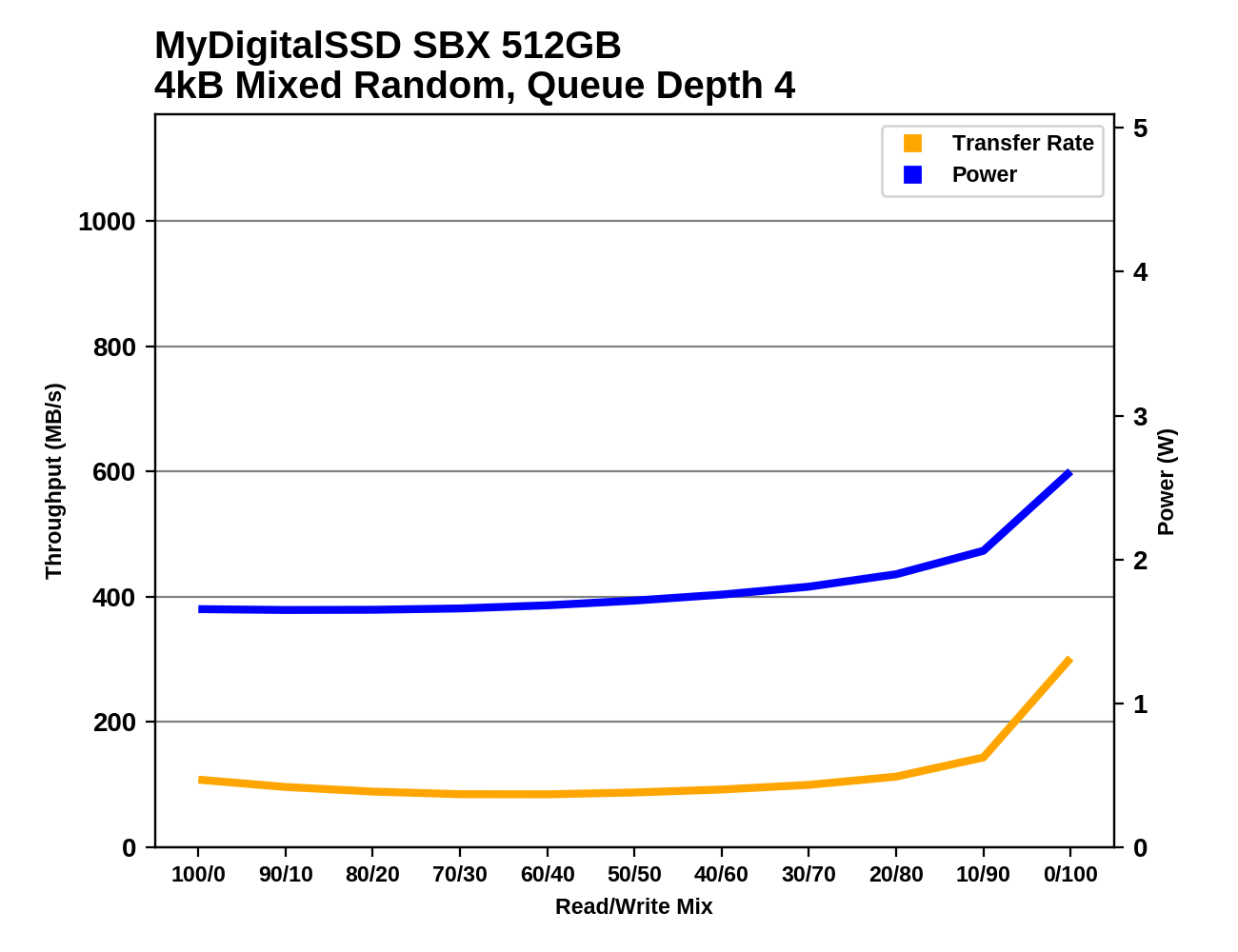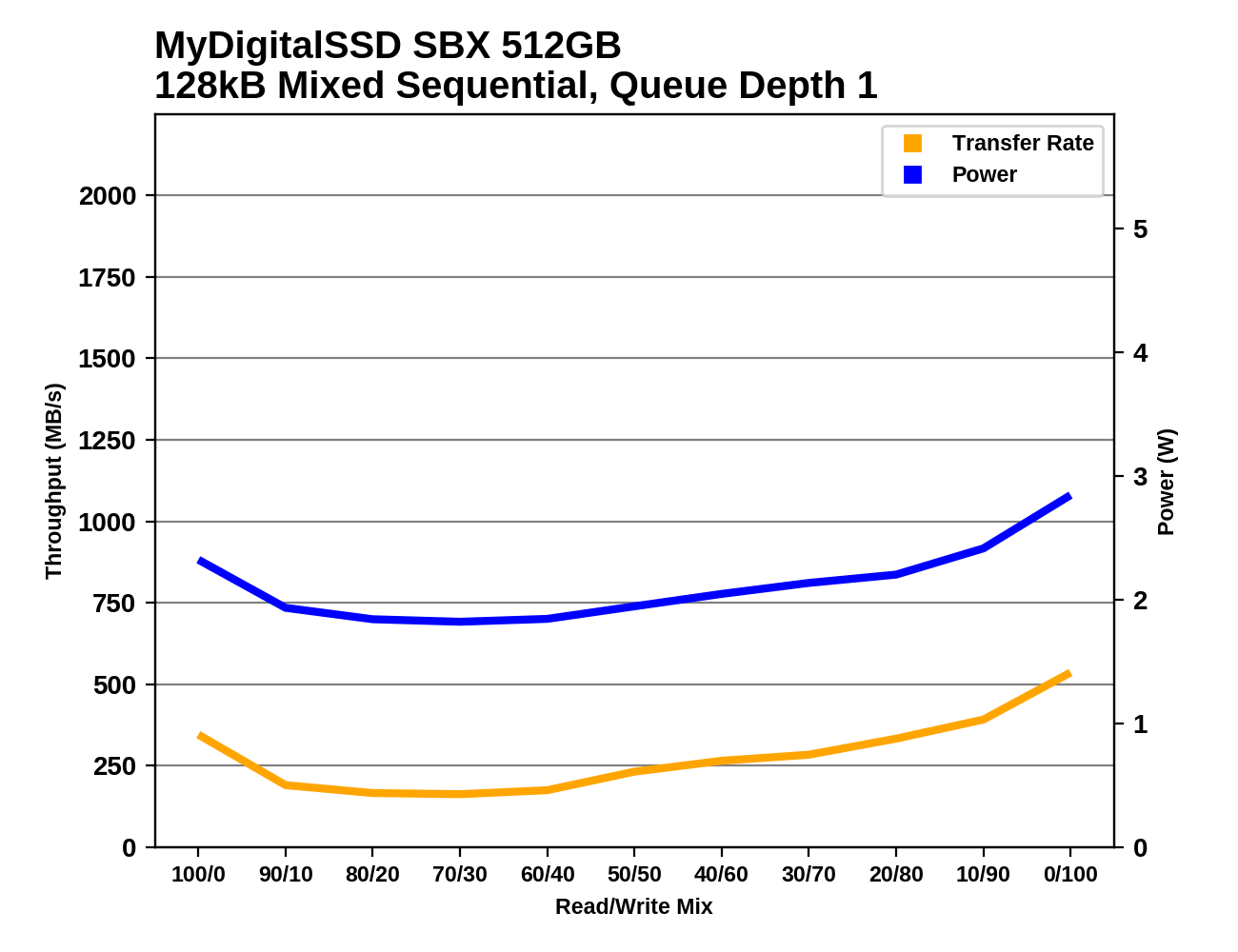The MyDigitalSSD SBX SSD Review: NVMe On The Cheap
by Billy Tallis on May 1, 2018 8:05 AM ESTMixed Random Performance
Our test of mixed random reads and writes covers mixes varying from pure reads to pure writes at 10% increments. Each mix is tested for up to 1 minute or 32GB of data transferred. The test is conducted with a queue depth of 4, and is limited to a 64GB span of the drive. In between each mix, the drive is given idle time of up to one minute so that the overall duty cycle is 50%.

The mixed random I/O performance of the MyDigitalSSD SBX is worse than mainstream SATA drives and all of the NVMe competition. The 512GB SBX even manages to be a bit slower than the 256GB model.
 |
|||||||||
| Power Efficiency in MB/s/W | Average Power in W | ||||||||
Despite poor performance, the larger two capacities of the SBX have reasonable power efficiency on the mixed random I/O test, and the smallest is at least more efficient than the Intel 760p. Looking at power consumption in absolute terms, there is a clear gap between all of the PCIe x4 drives using at least 2.2W and the SBX topping out at 1.8W.
 |
|||||||||
The shape of the performance curves for the SBX on the mixed random I/O test is typical: performance is low and mostly flat or slightly U-shaped for most of the test, then a clear increase in performance as the workload approaches pure random writes. That late boost in performance during the most write-heavy phases of the test is much smaller for the SBX than most high-end drives, and it isn't able to surpass the limits of SATA SSDs.
Mixed Sequential Performance
Our test of mixed sequential reads and writes differs from the mixed random I/O test by performing 128kB sequential accesses rather than 4kB accesses at random locations, and the sequential test is conducted at queue depth 1. The range of mixes tested is the same, and the timing and limits on data transfers are also the same as above.

As with the mixed random I/O test, the performance results for the mixed sequential test put the MyDigitalSSD SBX below the current crop of mainstream SSDs and below all the other NVMe SSDs in this comparison—though the latter result is more or less expected. It's disappointing to see even the Intel 600p outperform the SBX.
 |
|||||||||
| Power Efficiency in MB/s/W | Average Power in W | ||||||||
The power efficiency from the MyDigitalSSD SBX is low, but only the 128GB model stands out as being well below average, and it is at least joined at the bottom of the charts by several Intel drives. As usual, the absolute power draw of the SBX is more typical for a SATA drive than a NVMe drive.
 |
|||||||||
The performance of the MyDigitalSSD SBX drops during the early phases of the test, reaching a minimum with a relatively read-heavy workload before recovering slightly. In the second half of the test as the workload is more write-heavy, the 512GB SBX picks up speed but the 256GB and 128GB models stay at a roughly constant performance level. The 128GB then drops again in the final phase of the test with a pure write workload.










46 Comments
View All Comments
Mikewind Dale - Tuesday, May 1, 2018 - link
I'd like to see a low performance M.2 PCIe to USB enclosure just to make it easier to format and transfer drives. E.g., suppose you have a laptop with one M.2, and you want to upgrade. You'll have to make a disk image from M.2 PCIe, copy it to a SATA USB drive, then install the new M.2 drive and copy the image. You need a third drive in between. It'd be nice to copy straight from one M.2 drive to the other.dgingeri - Tuesday, May 1, 2018 - link
Well, as far as that goes, it would be nice if laptop makers would replace the 3.5" bay with two m.2 slots so it wouldn't be so much trouble for those very things. However, it seems laptop makers have their heads about as far up their behinds as is possible.peevee - Friday, May 4, 2018 - link
You will have zero benefit from NVMe on USB 3.0. Maybe USB 3.2.Samus - Tuesday, May 1, 2018 - link
Is there some reason the WD Black NVMe results are missing from all your charts, when you just did a review of that drive?Seems kind of weird considering it's this drives natural competitor.
Billy Tallis - Tuesday, May 1, 2018 - link
The new WD Black is more of a high-end NVMe drive in both price and performance. I didn't want to make the graphs too large, and I only have 1TB samples of the WD Black so it wouldn't be a fair comparison against the 512GB and smaller SBX.Dragonstongue - Tuesday, May 1, 2018 - link
seems that Crucial MX500 is a VERY good drive taking everything into accountprice is "reasonable" performance is also "reasonable" given the price.
to each their own, I kind of like the good ol 2.5" sata drive, they do not seem to have any throttle from heat related crud that so many of the u2 or m2 (whatever version you want to call them)
as pretty much all mobo put them really close to massive heat producing parts such as cpu or gpu and those stupid heatshields 9/10 are useless as crud ^.^
the other side of NVME based is not only does your motherboard have to support such (from OS as well as mobo point of view) seems there are many of them out there that are not as plug and play as they should be considering the cost IMO.
I am ok with a corvette over a station wagon (i.e SSD vs HDD) I do not have need to pay that extra $$$$$$ for a ferrari (that seems that given the proper workload are obviously WAY faster, but, run of the mill race, SSD are already fast enough and much more costly than a standard HDD to begin with)
moheban79 - Wednesday, May 2, 2018 - link
Anyone know if these nvme drives come with legacy option roms?peevee - Thursday, May 3, 2018 - link
Looks to me the drives were not in NVMe mode. Random performance should not be so much lower than SATA drives.MajGenRelativity - Thursday, May 3, 2018 - link
NVMe is not a "mode", and random performance is dependent on the drive, not the interface (up to a point)dgingeri - Friday, May 4, 2018 - link
Actually, yes, NVMe is a mode. The other mode is AHCI under PCIe, and all NVMe drives can operate in AHCI mode, and yes it does hurt random performance because the instruction parallelism allowed isn't nearly as wide under AHCI mode.https://www.anandtech.com/show/7843/testing-sata-e...